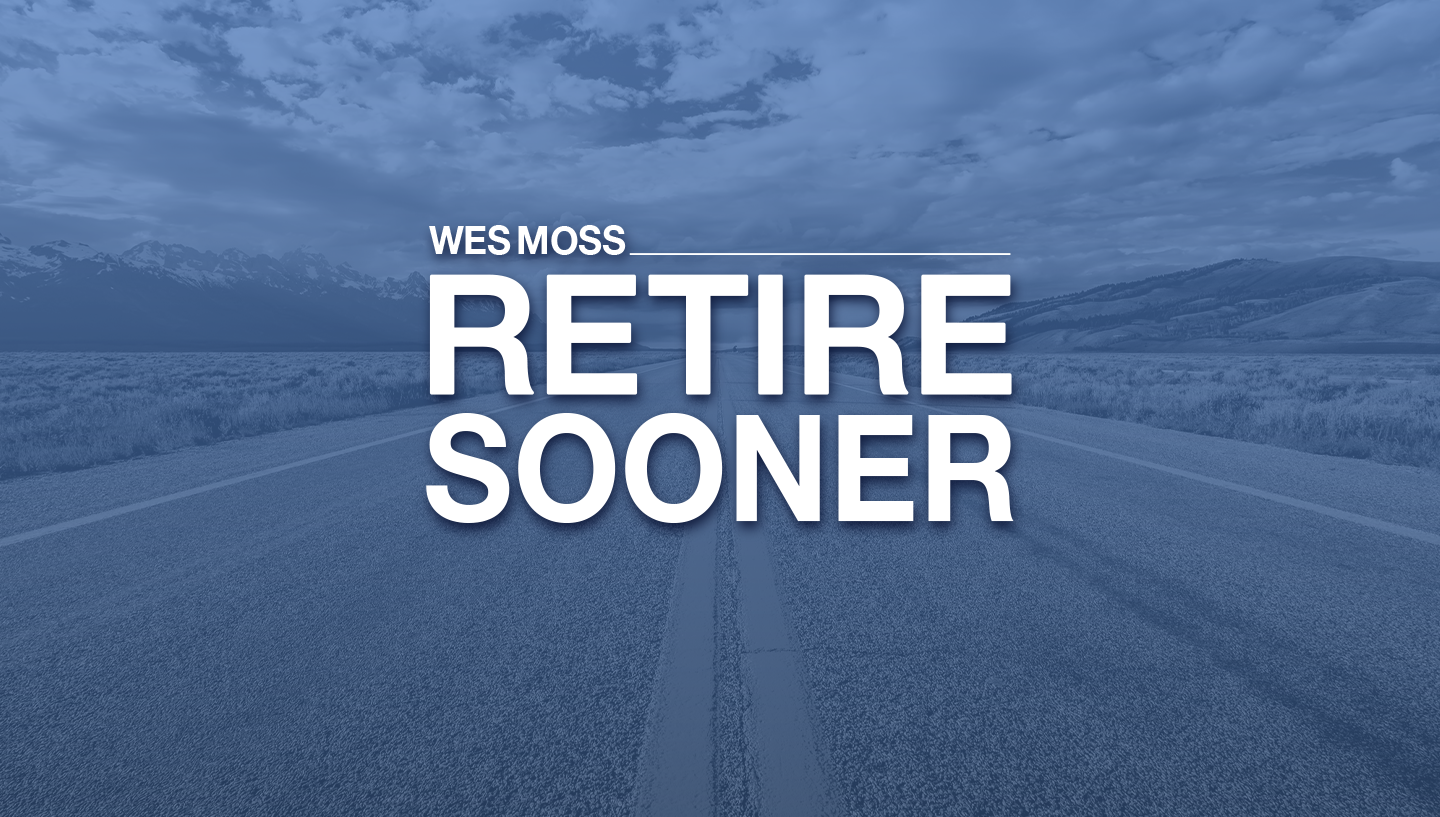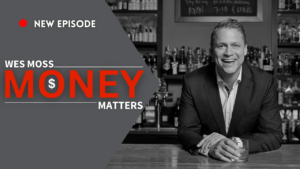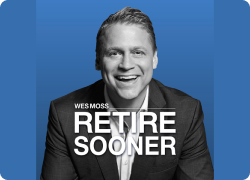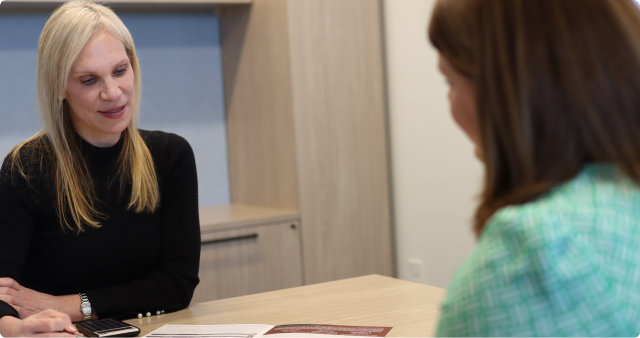Take control of your financial future. Learn how to determine the withdrawal rate for your retirement. Should you stick to the classic 4% rule, or is a 5% withdrawal rate possible? Hear why flexibility is key and how different spending approaches can impact your long-term security. Discover the impact of inflation, the pursuit of optimizing Social Security, and how a surprisingly small number of stocks make up about 50% of the S&P 500’s total value. Is it possible to time the market, or is participation a more strategic goal? Whether you’re years away from retirement or already there, this episode is packed with actionable advice to help you max out without running out. Tune in now as Wes Moss and Christa DiBiase break it all down!
Read The Full Transcript From This Episode
(click below to expand and read the full interview)
- Wes Moss [00:00:04]:
I’m Wes Moss. The prevailing thought in America is that you’ll never have enough money and it’s almost impossible to retire early. Actually, I think the opposite is true. For more than 20 years, I’ve been researching, studying and advising American families, including those who started late, on how to retire sooner and happier. Now I’m bringing in my good friend Christa DiBiase, who has worked closely with Clark Howard for many years now to answer your questions and explore what makes a happy and fulfilling retirement. My mission on the Retire Sooner podcast is to help a million people retire earlier while enjoying the adventure along the way. I’d love for you to be one of them. Let’s get started.Christa DiBiase [00:00:51]:
Very much looking forward to today’s show. I understand you’re going to talk about, first of all, can we withdraw 5% a year from our retirement account?Wes Moss [00:00:59]:
5%.Christa DiBiase [00:01:00]:
People are like, no way listening right now.Wes Moss [00:01:03]:
Now we’re going to talk about that.Christa DiBiase [00:01:04]:
And then also what happens one year after we have a market correction?Wes Moss [00:01:09]:
We’ve had our first official correction of 20, 25, down 10%. And the question is, where do we go from here historically? What do markets look like?Christa DiBiase [00:01:17]:
So let’s go ahead and start with that 5% rule.Wes Moss [00:01:20]:
It’s really, it’s a financial heresy. 5%, it’s a crazy number. And this is the great debate within financial planning. And we’ll never know the exact number today because we don’t know what the world’s going to throw at us. We don’t know how long we’re going to live, we don’t know how long, we don’t know what our rate of return will be over the course of our retirement or at any point in any period of time, Wouldn’t it be nice to know exactly what our rate of return would be, what inflation will be? So when we’re doing financial planning, we’ve got a dozen at least really important variables that make up a cash flow plan, a long term plan to make sure that we’re safely, not ever worrying about running out of money. It’s still a top fear in the United States. Running out of money is a very scary thought for anyone. But we go through this long period of time, 20, 30 years of 40 years of saving.Wes Moss [00:02:10]:
But if you were to boil down all those variables when you’re running a financial plan, it comes down to one. I would say the most important variable is your rate of withdrawal. Because the rate of withdrawal is saying, okay, how much of the savings that I’d spent 30, 40 years accumulating how much can I use in any given year? So, which means how much can I spend? What’s my standard of living going to be when I’m in retirement? So that is the crux of all financial planning. What is, for the most part, been agreed upon is this 4% withdrawal rate. William Bengan, the kind of the godfather of the 4% rule, ran a bunch of studies, ran market studies all the way back to the Depression and looked at different withdrawal rates. Because what we’re all trying to do, and I think of it this way, is max out without running out. Max out what? We’re withdrawing from our portfolios without having the fear of that going down to zero at some point when we still have a lot of years left on this planet. So there’s gotta be some sort of optimal number.Wes Moss [00:03:13]:
Now, anytime either market returns look as though they’re not going to be good anytime interest rates are low. Because part of most people’s withdrawal strategy needs to be a balanced portfolio. The 4% rule says you’ve got to have at least 50% in equities. That’s the engine that allows us to increase our spending for inflation over time. So if we assume that Bangin’s original work, which I’ve redone his study over and over and over again and kind of brought it up into the 2020s, and it still works, and I actually call it the 4% plus rule. But this past fall, Barron’s made a big splash and came out with an article that said, you may be able to do, or really they said, you can do 5%. You can have a 5% withdrawal rate. Now, the counter to that, and there’s several financial folks in the financial planning community that’ll come out and say, no, no, no, no.Wes Moss [00:04:08]:
If you really want to be safe, just pull out 2.5%, or that’s your max withdrawal rate. And when that starts to happen, that kind of frustrates me because of course, if you barely take any of your savings out over time, of course you’re not going to run out. But then what’s the point of the savings? So there’s got to be this happy medium. So Barron’s comes out and says 5%. You can do that. Well, how do they get to that point? One, they say that recently some of the big Wall street firms have come out and said because interest rates are higher at the end of last year, that means your bond should produce more over time. So those expectations are higher. The equity market should do 8% a year, according to.Wes Moss [00:04:50]:
I think it was JP Morgan or Morgan Stanley, one of the Wall street firms. So those return assumptions are pretty healthy. And if both sides of your equation, stocks and bonds, both do well, well then maybe you can pull out more money the way Bengen said. And this is from a year or two ago, he said you could give yourself a retirement raise by adding in some small companies that typically have a higher rate of return over time. So he’s suggested that 4% is even too low. So I wanted to go back and see what makes this possible. And we ran the numbers, so I’ll look historically, I’ll share with our listeners. What does it look like if we start out with 5% and withdraw 5% plus inflation every year over time? What’s our probability of never running out of money? The first point in all of this, whether you subscribe to 4% or 4.5% or 5 or even higher, is about flexibility.Wes Moss [00:05:47]:
Because in the real world, Christa, we don’t turn on our financial spigot from our accounts and say, okay, I’m getting my four and a quarter percent and I’m going to perfectly ratchet that up exactly for CPI or inflation every single year until the end of time. That’s just not how it works in real life. So flexibility is the key, meaning that we may go through a period of time where markets are really good and they’re really strong and they’re beyond our expectations. And you can say, gosh, I think I can take out a little bit more money or we can go on an extra trip or two that I hadn’t thought I could budget for. Same thing. When we go through a protracted stretch of not great markets and really low interest rates, we want to be able to be flexible to say, well, maybe we spend a little bit less. That’s the real world when it comes to managing your withdrawal rate. But what are the numbers say, and this is, and our team has run every single calculation that you can think of, 4% with different portfolio allocations.Wes Moss [00:06:47]:
5%, we’ve, we’ve looked at 6%, which money does run out pretty quickly at a higher percentage of stretches. That one I think is, is probably a little bit too aggressive. But if we’re just looking at the numbers and if we look at a 5% withdrawal rate now, what’s interesting, if you look at 5%, your best opportunity to not run out at least for 30 years, actually looking at an all stock portfolio now, a balanced portfolio works as well. But here are the numbers. If we’re looking at a 30 year period of time, a 5% withdrawal rate plus inflation. Using the same metrics of this rule, money still doesn’t run out 83% of the time. So 8 out of 10 times you turn on the 5% withdrawal rate and this is going all the way back into 1927. And imagine you retired in any given year over that entire stretch of history.Wes Moss [00:07:43]:
So 8 out of 10 times 5% rule actually works based on history. Now you’re going to say, wait a minute, well, I don’t want to go into retirement thinking I get an 8 out of 10 chance that I’m going to be okay and not run out of money. So it is riskier. But that’s where the flexibility comes in. And I think that if you start out with a higher percentage withdrawal rate, you just know you have to be flexible if things turn and we go through really rough stretches. However, here are the scary numbers and why you may not want to subscribe to 5% is that if you go and look over that almost 100 years of data, you do have some rough outcomes. And the worst outcome is money ran out in 12 years. That’s no good.Wes Moss [00:08:25]:
The fifth worst outcome was that money ran out over 19 years. However, again, 83% of the time, money lasted for 30 years plus, 80% of the time, 35 years plus and 79% greater than 40 years without running out of money. So the way I would look at it historically, looking at market data and making sure you had a portfolio that was, that is now in this case, this was a hundred percent stock portfolio, which is where we typically over time get our best rates of return. I would say it’s very possible to do, but it’s just a riskier approach to take. If you go to a balanced portfolio, Christa, where you have 60% stocks and 40% bonds and you use a 5% withdrawal rate, it is still 83% of the time. It lasts 30 years plus and the percentages drop a little bit as you start making things last even longer. 35 years, it’s only a 70% probability that works. And a 45 year period, it’s only a 55% probability that it works.Wes Moss [00:09:29]:
So money does run out quicker, obviously because we’re starting at a higher withdrawal rate. So the key to me goes back to flexibility. I still believe 4% is a safer route to take and it’s trying to max out what you’re withdrawing without running out. Those probabilities are that’s where you get into the 99% probability that you’re not going to run out. So it’s possible. It’s just a little riskier path to take. And it’s a debate, by the way, that will be never ending.Christa DiBiase [00:10:00]:
All right, we’ll go to questions now. This came in from Chip in Texas. I’m an avid listener and love Clark’s approach to saving and spending less than you make. My kids all have benefited from his sage advice. This is probably for Wes. And I love the new dedication financial information. My wife is two years older than I am and will not earn the 40 quarters needed to get Social Security on her own. I’m not sure how to think about when to take Social Security.Christa DiBiase [00:10:26]:
I think I’ve been concentrating too much on when she reaches 70 and I’m 68 that I should take Social Security. If she was my same age, I wouldn’t have that thought. So is it still worthwhile to take Social Security when I reach 70 to get my full amount and half of the 67amount for the spousal benefit or. Or are there other considerations? Our parents lived long into their 90s, so I am planning to pass the crossover points that seem to be in.Wes Moss [00:10:52]:
The 80s longevity chip, God willing. And I pray that you also have lots of longevity. That’s one of the things I think about every day, longevity. I pray for that every day longevity for all of us and everyone around me. So I’m with you on that, Chip. I would say this. When it comes to planning for Social Security, we hear a lot about maximizing Social Security and that’s easier to do because we know. Well, it’s not perfectly easy to do because we don’t know how long we’re going to live.Wes Moss [00:11:23]:
But if you knew you’re going to live into your 90s chip, then the best way to do this is just wait till 70 and then wait to take for you for 70 and then, because hopefully your wife has lots of longevity, she gets a full 50% of that, the highest number you can get. But really, the way I think about Social Security is not about maximizing, it’s about optimizing it. Meaning that you want it to be the right fit for you and you want to start taking it in the right year. So to me, it’s not about maximizing, it’s optimizing for your particular financial situation. Now, in your case, and I’m keying in on this, if you’re like your parents and you do live in your 80s and 90s, you got a long way to go. And meaning that you, if you do wait, you should have the years to make up with these now higher payments because you waited for the years that you didn’t take Social Security. And I would be leaning, I think what you’re, the way you’re thinking about this, she can’t collect Social Security until you start taking your Social Security. And she’ll get 50% of whatever you’re getting if you wait till your FRA, the full retirement age.Wes Moss [00:12:32]:
And sounds like he’s already there if he’s 68. So sure, you could go ahead and take it. You hit your fra, she should get 50% of that, but it’s 50% of a lower number. So this goes back to, in this case, I would lean towards waiting till 70 because first of all, those numbers get to be really significant. You wait till 70 and I don’t know the exact number for you, Chip, but I’ve seen, you know, 3,000, 3,500 over. I’ve seen people get over $4,000 a month if they’re waiting all the way to 70. And then you get half of that. So that’s, let’s call it, you get four, she gets to, you get $6,000 a month, which is really significant.Wes Moss [00:13:12]:
And then the next benefit of waiting and having that higher number, if you do pass away first, she now assumes your higher payment. So the waiting then also benefits her almost as a little bit of an income insurance policy. So it’s not the perfect and black and white right answer to say wait till 70. However, I would lean towards that. Knowing the longevity in your family and the situation that your wife is not able to collect social, I’d be leaning towards waiting.Christa DiBiase [00:13:43]:
This came in from Andy in Idaho. Wes, a couple weeks ago, you suggested to a listener to spread out the Roth conversions over a number of years to minimize the balance in the tax deferred accounts before RMDs kick in. Is that really the best way to go? Sure. Depending on if you have other income streams, the RMD might increase the tax burden. But wouldn’t it be a benefit to leave some funds in the tax deferred accounts to be able to use the standard deduction for RMD conversion after the age of 73, and if so, how much should be left in the accounts?Wes Moss [00:14:16]:
Andy’s not totally wrong in that thinking. So, first of all, it’s not. I still say, yes, you want to spread out your Roth conversions, and it’s still about taxes today versus taxes tomorrow. And yes, for a lot of people, RMDs the required minimum money you have to take out of your IRAs. It does lift people’s tax bracket because you’re having to take out money. So practically by the time you’re 73, you not only have your Social Security and maybe a pension and your RMDs, you’re going to have a fair amount of money coming in. And usually you want to have most of your Roth conversions done by then because now you’re being forced to pull money out of your retirement accounts. Now, if you’ve done most of the job, think about it.Wes Moss [00:14:59]:
If you only have 50,000 or 30,000 left in an IRA by the time you’re 73, your RMDs aren’t going to be that much anyway. So they’re not going to have. It’s not going to be a huge amount of income. And again, I would, I’m going to couch this and with, with a little caveat here, is that tax taxes are super complicated and there are these rolling progressive tax brackets and every bit of income you assume or receive in a year, it’s not just a black and white calculation, it’s a progressive and rolling calculation. So you’ve got to run the tax calculation, meet with your CPA, and speak with your tax advisor on this. But the way I look at this is when you’re doing a conversion, a Roth conversion, you’re creating income. And if you are creating income and it’s still at a relatively low amount, then, sure, your standard deduction could work. And I’ve sat with people that have done this in lower tax years.Wes Moss [00:15:56]:
Let’s say you’re a student and you’re not making any money or waiting before you really get employed. Well, you’ve got a pretty easy Roth conversion there, and your standard deduction can really offset a bunch of it. Now, you can’t do $100,000 conversion, but if you’re doing $15,000 and your standard deduction is $15,000, then sure, there’s going to be a really big offset. So, Andy, it’s actually a good idea and a good thought that even when you get to 73, if you still have some converting left that you’d like to do, the standard deduction could help.Christa DiBiase [00:16:28]:
Okay. And Patrick in Massachusetts sent you this one. I get shares of my company stock as part of my compensation. I’m not planning on keeping these as part of my investment portfolio. And I typically donate the shares. Does it make sense to wait and see at the end of the year? If the shares are up and donate as they will have more value, or down and sell using capital losses to offset tax, then donate the cash Equivalent or should I just donate regardless?Wes Moss [00:16:56]:
I think just donate regardless because this we don’t know where we’re going to be at the end of the year. So if you, if you knew that, hey, I’m just going to wait till the end of the year when my shares are higher, well, then we would also, we put all of our money into those shares if we really knew they were going to be higher. So that would also require a crystal ball. And if you’ve got one of those, I’d love to take a look. But he’s right. And this is for anybody thinking about donating stock if it’s appreciated. So if you paid $10 for stock and even if when you’re getting stock from a company, you’re still gonna have a basis on this and if it’s higher, then you are in usually a better situation to donate that. If you’re looking to donate money because you don’t have to sell, pay taxes on the capital gain and then donate the cash, you’re allowed to donate the appreciated stock and you get the deduction amount for the full value subject to, by the way, 30%.Wes Moss [00:17:57]:
You only do up to 30% of your adjusted gross income. So if you make $100,000 a year, the max you can do if it’s stock is 30%. 30,000, the max you could do for cash. Cash is 60. So if you make 100,000, you could don’t. You can get a deduction up to 60,000. You donate more. Christa, you want to give away more than.Wes Moss [00:18:16]:
So those are the parameters. 31st, 30% for stock appreciated, 60% for cash. But he’s totally right. And you’re, you’re right thinking about if the stock is lower today or if you wait a couple of months, then you don’t have a capital gain event to sell it and you can actually take the loss. And a loss is an asset because you can offset other gains. You could even on your taxes. Again, consult your tax advisor. But you can take up to $3,000 of a capital loss against and you can use that on your taxes.Wes Moss [00:18:52]:
So if it’s down, you’re better off selling it, donating the cash if it’s up appreciated stock, better to do it that way. And it’s in. We don’t know where the stock is going. So I usually would just advise. If you know you’re going to make the donation, then I would do that as soon as it is available to do.Christa DiBiase [00:19:11]:
Okay, so coming up straight ahead, you’re going to talk about what happens A year after a correction in the market.Wes Moss [00:19:18]:
Let’s talk about markets.Christa DiBiase [00:19:20]:
All right, we’ll be right back.Wes Moss [00:19:23]:
Are you facing a fork in the road and deciding between continuing your career and retirement? I’m Wes Moss, host of Money Matters, and this massive life decision shouldn’t be taken lightly. Talk with my team. If you’d like help reviewing your retirement accounts and building a financial plan, we can help you review options and offer an opinion based on your best interests. You can find us@yourwealth.com that’s y o u r wealth.com.Christa DiBiase [00:19:54]:
Let’S get into it.Wes Moss [00:19:55]:
What happens after a question? Markets crack 10%. Scary worries, tariffs, the doge, what’s happening to the economy, recession. What’s your worry level when this happens? On a scale of 1 to 10, 10 freaked out ones. Just no care whatsoever. Love it.Christa DiBiase [00:20:13]:
I would say because I’ve worked with Clark and I’ve known you for so long, I don’t panic. Um, I really don’t panic.Wes Moss [00:20:20]:
What about down 20%?Christa DiBiase [00:20:21]:
Um, I don’t because I still feel like I have a long view. I want to work for a long time, but I understand why people get very, very panicked.Wes Moss [00:20:29]:
Does your anxiety go up at all or literally just stays flatlined?Christa DiBiase [00:20:32]:
Um, I’m pretty flatlined with it because I just, I don’t even look at my accounts when it’s like this. I just try to steady as I go, as Clark has always. I mean, it’s been, I’ve worked with Clark for almost 28 years and it’s, he’s taught me that and I’ve seen a lot of ups and downs and I just try to keep putting my money in every month and trust, trust this process. Yes.Wes Moss [00:20:55]:
Well, listen, so unlike Christa, if you have human emotion here, then. And again, I think it’s great because really you’ve been educated from this and you have a high level of conviction. And that’s part of why educating and reading markets and market history, it really works. It helps to understand where it’s not that you don’t have emotion, of course, it’s that it doesn’t bother you, but it bothers a lot of folks. And that’s just called being human. It’s human emotion. It’s not enjoyable to see your account value drop. The pain of loss is four times as impactful as the joy of gain.Wes Moss [00:21:30]:
Right. So we win $100, we have a 2 on the excitement meter. We lose $100, we have a negative, you know, 8 on the pain meter. That’s just how we’re wired. So it’s important to kind of understand that as we go through market correction. So a lot of folks may be like oh, a 10% correction, I get it. However, it does raise eyebrows and it does worry people and I know that because we get lot I get lots of emails about this anytime the market has almost any hiccup. And so we, we had a full blown correction.Wes Moss [00:22:02]:
It’s in the books as one of now probably 49 since we’ve had World War II. So we had, first of all we’ve had about 50, almost 50 corrections of 10% or more since World War II happen a lot. And the question is not so much the 10%, it’s more hey wait a minute, is this going to go to 20? Are we getting into a bear market or remember when we went through the early 2000s right after the 99 stock market tech bubble, the S&P 500 went down almost 50%. Now that’s tough. I think even you might get a little nervous about that.Christa DiBiase [00:22:37]:
Sure I would.Wes Moss [00:22:39]:
And then that happened again in the great financial crisis. We’re down almost 50% for the S&P 500. Now that didn’t last long when we got to that level. But those hurt. So the natural question I think is well what happens normally when we do go down 10% and if you pull statistics from, if you go all the way back to the 40s we’ve had call it now these are statistics before the most recent correction but statistically we had 48 of them before the PAT this past 1 and 75% of the time Christa, it did not turn into a bear market. So 75% of the time, three quarters of the time it did not go to the 20% or worse mark. So to me that doesn’t mean we’re not going to go continue to go further down. It just shows that most of the time 10% corrections just don’t turn into full blown bear markets.Wes Moss [00:23:31]:
So that’s one data point I think it’s interesting and important. Secondly, if you go back again, let’s go back, this one goes back to 1980s, the 1980s and we’ve had 21 corrections since then. Well where are returns six months later, a year later? And I think that’s really instructive too. So there’s two kinds of corrections. You get a correction that’s not accompanied by a recession. So that’s just general market fear. Economy’s still going, every underlying it’s still strong but we’re just nervous and maybe stocks are overvalued and they pull back. If you look at that type of pullback, then a year later, stock markets are up 12%.Wes Moss [00:24:10]:
Up 12% 12 months later. Now if you were to look at all from the low, from the minus 10% threshold. So once you go down 10, we, and you look at that level, we’re up 11 to 12% a year later. Now if you do look at the corrections that are accompanied by bad economy, by a recession, we’re not dramatically higher a year later, but we are actually at least a little bit higher. So historically we’re up 1 to 2% 12 months later. So that’s the data we do recover.Christa DiBiase [00:24:45]:
I have to say also, Wes, just a note like Clark always likes to say, well, when this, when things are low, they’re kind of on sale. And so you keep putting, you know, dollar cost averaging. You put your money in, you’re buying at a lower price. And I remember during a big correction when my kids were really little, I had some cash and I decided to put it in their 529 accounts when markets were down. And it really benefited me over time since especially because my daughter went to a very expensive college.Wes Moss [00:25:14]:
There’s a quote I like about this period of time which is about corrections is that the stock market is the only store that people run to the exits when prices go down. Right. But our natural intuition is not that prices are on sale, it’s that they’re going to keep going lower. I think that’s really, that’s really the fear. Here’s another. If we go back over economic history, we actually have not had a period of time where we’ve had three bear markets. So again, we’re worried. Most people are, we’re dealing with 10% correction.Wes Moss [00:25:48]:
But is it going to get to a bear market? Is it going to get worse? And the reality is over the past, going all the way back to the 50s, we have not had 3 minus 20% within five years. And so again, it would be improbable because we had 1 In 2020, we had a bear market then we had another bear Market in 2022. So to have another one here in 2025, again, history doesn’t point to that. And then probably Christa, the I think the most practical part about looking at these corrections and why we don’t want to sell out and go to cash, if you look over the course of economic stock market history and you were to do a tiny little dot for every day, whether we’re up or down and go back, you look at a 80 or 100 year period, almost every single time you find a big down day or a big heavy correction that happens quickly, it almost always lines up within days or weeks or certainly within months that we have a big snapback. So almost every really bad down day or down week is accompanied in close proximity by a really big update. So that just goes to show that the speed of declines and this was the fifth fastest 10% correction we’ve had in history really happened quickly. And I think that also worried people. But over the course of stock market history, the faster the decline, usually the faster recovery.Wes Moss [00:27:16]:
Which just goes to the fact that it’s almost impossible to be able to time getting out and then getting right back in to get these stat backs. So we can’t really time it. It’s almost impossible to do so. So we have to have your perspective, Christa, which is conviction that over time markets will do well because the American economy is hard to stop. I think of it as the army of American productivity. A, the army of American productivity doesn’t panic and B, it just keeps marching forward.Christa DiBiase [00:27:46]:
All right, now we’ll go to some questions. This one came in from sriram in Washington. One, what is your opinion about the S&P 500 being top heavy? Top 20 stocks make up about 50% of the total value, which is unprecedented historically. How can investors protect their portfolio in this scenario? Two, is passive investing the reason for the top heavy market and the links to an article? And three, do you expect the future stock market returns to be comparable to historical returns? How does the low Fed interest rate affect returns?Wes Moss [00:28:20]:
Okay, so there have been a lot of articles about this recently. So first of all, if you go back over the last couple of years, you’re absolutely right that we’ve had more concentration in the top 10 and 20 names than we’ve seen historically. Now it is not Rare to have 20, 25% concentrated in the top 10 names. That’s pretty normal because the S&P 500 is cap weighted. It’s weighted by size. And the biggest companies at the top typically do take up 25%. The top just those 10. What’s happened is it’s become even more concentrated.Wes Moss [00:28:57]:
So that was a big story over the last couple of years that the mega cap companies were now are getting 30%, 32%. Where are we today? Almost 35%. Is it because of passive investing? I don’t think it is. I can see how you could make an argument that yeah, passive investing is pushing up the top 10 names. I don’t think that’s the case. I think that the companies that have emerged to be the biggest have gotten there because they have such incredibly strong businesses that investors have flocked to that. Now. It hasn’t hurt that more people have been putting money into passive indexes and strategies that continue to feed that.Wes Moss [00:29:39]:
But it’s not that new of a phenomenon. I’d say it’s even more so the case concentration at the top. But again, a lot of that is because the properties of the companies. The second thought here is is that a problem? Is passive investing a problem and is it creating this imbalance? And my opinion there is that it’s important to know this, is that we think, oh, the s and P500, it’s super diversified, which it is. But is it that diversified when 35% of it or 50% is really only 20 names? So I think it is important for investors to know that and understand that I don’t think it’s a problem. There is some commentary out there that it’s creating a bubble that will take down the stock market. But if you look and there’s no perfect answer here, we have $30 trillion in investment assets in the U.S. and almost, you could make the case that almost half of that is in some sort of passive vehicle.Wes Moss [00:30:38]:
But there’s $145 trillion in assets under management around the globe and only about 15 trillion. That’s, that’s index fund passive here in the United States. So really that’s only 10%, which means there are millions and millions of people and trades and trillions and trillions of dollars that are still active managers looking for price discovery. And get it, we’re getting to a price that investors are agreeing upon. I don’t think the, the passive movement, which has been around now for three decades, I don’t think that’s creating a bubble necessarily. However, this is a very important point. By only doing, let’s call it the s and P500, you should know that half of your money really is in 20 stocks. Which leads us to saying, okay, how do you diversify around that? The short answer here is it’s super easy to do.Wes Moss [00:31:34]:
There are hundreds and thousands of other options out there, other ETFs, other low cost funds that are not indexes to the S&P 500 and they’re not overly top heavy. In fact, you can find equal weighted indexes or ETFs, equal sector ETFs. You can buy individual ETFs that don’t have as big of an exposure in the S&P 500. So I do like to have, even though I do own some S&P 500, I like to have other ETFs that make it so that I have a better balance, knowing that that index is top heavy.Christa DiBiase [00:32:09]:
And the third part of that, do you expect the future stock market returns to be comparable to historical returns?Wes Moss [00:32:14]:
No, I can’t answer that. I don’t know.Christa DiBiase [00:32:18]:
Crystal ball.Wes Moss [00:32:20]:
We had a question earlier that maybe he had a crystal ball. Nobody can tell you that. Nobody knows where we’re going to be in a year from now. But if you’re a student of market history and the US Economy, we know we push forward. So I’m a big believer of reversion to the mean, meaning that what we’ve seen over a hundred years will continue to play out over time. So I don’t know if the market will be up 9 or 10% in any given year. But I still believe over time, and this is why I still invest and believe in it, is that I think our average returns will still be there as long as we’re in the game for long enough.Christa DiBiase [00:32:56]:
How many times a day do you get that question from clients?Wes Moss [00:32:59]:
I don’t know. Most people do ask that, well, how are we going to do this year?Christa DiBiase [00:33:04]:
Yeah. Yeah. Okay. This one came in from Pater in New York. Question for Wes. I’m 35, married, and we both started maxing out our Roth 401k contributions this year. We also max out our annual HSA contributions. Invest and invest the funds.Christa DiBiase [00:33:18]:
Both the Roth 401k and HSA investments go entirely towards a target Date fund.Wes Moss [00:33:24]:
A Schwab Target date fund, the 2055, specifically 5. That’s way out there.Christa DiBiase [00:33:29]:
Is the diversification in these funds enough to keep us covered as we save towards retirement, or is funneling 100% of our retirement investments into a single target date fund a bad idea?Wes Moss [00:33:39]:
The short answer is it’s totally fine. I think it’s a good solution for a lot of folks. I’m not saying this particular fund, but like most target date funds, this one, if you’re going out 25 year or 30 years, 2055, the target date fund will be heavily weighted towards stocks. I think this Schwab one is probably 90, 93% in equities and the rest is in fixed income. So it’s just a small amount so that we have a little bit of dry powder, but mostly towards equities. And he’s 35 and it’s US and it’s international. It’s small cap. I believe there’s different sectors, actually.Wes Moss [00:34:15]:
I think the way these work, these target date funds are funds of different ETFs for the different sectors. So it’s almost like a fund of low cost ETFs. So I’m not commenting whether it’s a good or a bad investment. I’m just saying that almost any target date fund for somebody that young and 35, that’s appropriate. It’s appropriate. It’s super diversified. If you look and see just any one of those individual ETFs that are stock based are super broad, 3, 4, 5, 700 different positions. So we have a lot of diversification within each sliver of that overall pie chart.Wes Moss [00:34:56]:
Now, the only time I really have problems with target date funds are. My main issue is that if you were to be in one of these target date funds, that’s a 20, 25 this year that we’re in. And this is your retirement year. Many of them are 60% in bonds. So you’re starting out this retirement journey, which God willing, is another 30 years. I think with too little exposure to equity markets, which are really our inflation fighting elixir. Bonds can keep up with inflation and they should over time. Equities are there to outpace inflation so we can give ourselves a raise.Wes Moss [00:35:35]:
So in these early stages, you want to be mostly equities anyway, if you have the risk tolerance for it. But I run into issues with target date funds when I’m getting close to that retirement date. I think they can get overly conservative for most people, not everyone.Christa DiBiase [00:35:50]:
All right, that does it for us.Wes Moss [00:35:51]:
Three parter.Christa DiBiase [00:35:52]:
That was a three parter.Wes Moss [00:35:53]:
No, no, the one before it was.Christa DiBiase [00:35:55]:
The one before it was.Wes Moss [00:35:56]:
Yep, they’re all running together, but they’re all really cool questions. And I think the reason I’ve always liked doing this, Chris, is that even though you don’t have the question and you’re listening, it might pertain to you in some way. And I think when you’re hearing other people that are having a struggle or question or you’re in a financial quandary and we’re working through that, I think people can relate to that and I think that’s why these can be helpful. I’m looking forward to more of our listener questions. So if you have any questions you’d like us to answer in future episodes, I’d love to hear from you. You can send them in to us through YourWealth.com contact.Mallory [00:36:38]:
Hey y’all, this is Mallory with the Retire Sooner Team. Please Be sure to rate and subscribe to this podcast and share it with a friend. If you have any questions, you can find us@westmoss.com that’s W-E-S-M-O-S S.com. you can also follow us on Instagram and YouTube. You’ll find us under the handle Retire Sooner podcast and now for our show’s Disclosure this is provided as a resource for informational purposes and is not to be viewed as investment advice or recommendations. This information is being presented without consideration of the investment objectives, risk tolerance, or financial circumstances of any specific investor and might not be suitable for all investors. The mention of any company is provided to you for informational purposes and as an example and is not to be considered investment advice or recommendation or an endorsement of any particular company. Past performance is not indicative of future results.Mallory [00:37:27]:
Investing involves risk, including possible loss of principal. There is no guarantee offered that investment, return, yield or performance will be achieved. The information provided is strictly an opinion and for informational purposes only, and it is not known whether the strategies will be successful. There are many aspects and criteria that must be examined and considered before investing. This information is not intended to and should not form a primary basis for any investment decision that you may make. Always consult your own legal, tax or investment advisor before making any investment, tax, estate or financial planning considerations or decisions. Investment decisions should not be made solely based on information contained herein.
Call in with your financial questions for our team to answer: 800-805-6301
Join other happy retirees on our Retire Sooner Facebook Group: https://www.facebook.com/groups/retiresoonerpodcast
This information is provided to you as a resource for educational purposes and as an example only and is not to be considered investment advice or recommendation or an endorsement of any particular security. Investing involves risk, including the possible loss of principal. There is no guarantee offered that investment return, yield, or performance will be achieved. There will be periods of performance fluctuations, including periods of negative returns and periods where dividends will not be paid. Past performance is not indicative of future results when considering any investment vehicle. The mention of any specific security should not be inferred as having been successful or responsible for any investor achieving their investment goals. Additionally, the mention of any specific security is not to infer investment success of the security or of any portfolio. A reader may request a list of all recommendations made by Capital Investment Advisors within the immediately preceding period of one year upon written request to Capital Investment Advisors. It is not known whether any investor holding the mentioned securities have achieved their investment goals or experienced appreciation of their portfolio. This information is being presented without consideration of the investment objectives, risk tolerance, or financial circumstances of any specific investor and might not be suitable for all investors. This information is not intended to, and should not, form a primary basis for any investment decision that you may make. Always consult your own legal, tax, or investment advisor before making any investment/tax/estate/financial planning considerations or decisions.










